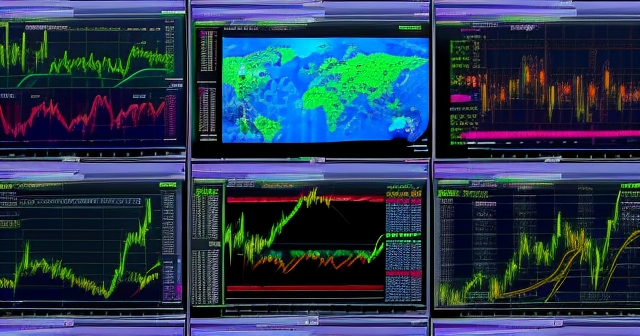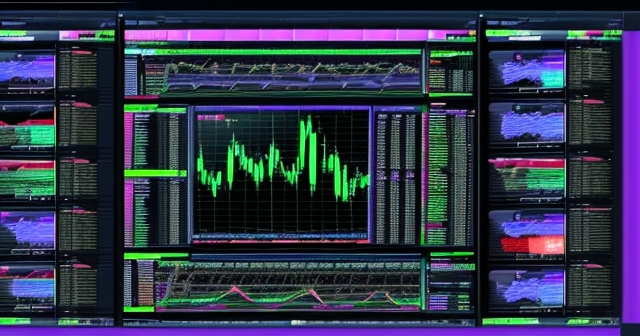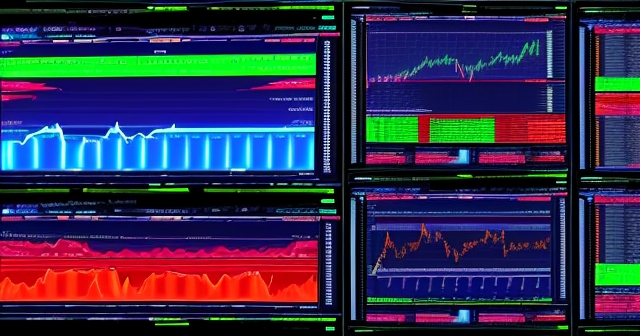The Evolving Landscape of Spot FX Trading: Navigating Complexity
Welcome to the dynamic world of spot FX trading. It’s a market characterized by immense scale, constant evolution, and increasingly intricate layers of technology and regulation. If you’re navigating these waters, whether as a newcomer or a seasoned trader looking to deepen your understanding, you know that staying ahead means grasping the fundamental shifts occurring beneath the surface.

Today, we’re seeing significant forces reshape how spot foreign exchange is traded, priced, and settled. Think of it like a complex engine where some gears are being replaced, others are speeding up dramatically, and the rules of operation are constantly being updated. Understanding these changes isn’t just academic; it’s crucial for managing risk, optimizing execution, and ultimately, achieving your trading objectives. We’re going to delve into some of the most pressing challenges and fascinating developments shaping the market right now, breaking down complex ideas into understandable insights.
From the potentially disruptive impact of new settlement cycles to the subtle but powerful influence of technology and evolving market structures, we’ll explore the key trends that are defining the spot FX landscape. We’ll look at how participants are adapting, what regulators are focusing on, and where the next sources of volatility and opportunity might lie. Are you ready to explore this complex, fast-moving environment with us?
| Key Trends | Impact on Spot FX Trading | Implications for Traders |
|---|---|---|
| Emergence of T+1 Settlement | Accelerated transaction timelines increase risks. | Traders must adapt to tighter execution windows. |
| Technological Advancements | Rising influence of algos and automation. | Understanding and leveraging technology becomes crucial. |
| Market Fragmentation | Numerous platforms complicate access to liquidity. | Effective platform selection and connectivity management are essential. |
The Imminent Challenge of T+1 Settlement: Heightened Risks and Operational Strains
One of the most significant systemic shifts facing financial markets globally is the move towards a T+1 settlement cycle for securities, particularly in North America. While this primarily affects equity and bond markets, its repercussions for the interconnected spot FX market are profound and far-reaching. Why? Because buying or selling foreign securities often requires a corresponding FX transaction to settle the trade in the correct currency.
Imagine you’re a fund manager in Europe buying US stocks. The equity trade will now settle in one day (T+1). However, the FX trade to convert Euros to US Dollars might still operate on a T+2 cycle, or simply face tighter operational windows. This timing mismatch creates what’s known as settlement risk – the risk that one leg of a transaction settles, but the other fails, potentially leaving a party exposed to market movements or counterparty default.
For FX dealers and market-makers, this accelerated settlement timeline introduces considerable operational stress, particularly towards the end of the North American trading day. As asset managers rush to execute FX hedges or conversions needed for T+1 settlement, dealers face compressed timelines to process and confirm these trades. This end-of-day scramble can lead to inefficiencies and increased pressure on internal systems and processes. It’s like trying to cram two days’ worth of packing into a few frantic hours before a trip – something is bound to get stressed or potentially overlooked.

Settlement Beyond CLS: Understanding Liquidity Shortfalls and Wider Spreads
The T+1 shift exacerbates existing vulnerabilities in FX settlement, especially concerning trades that cannot be settled through CLS (Continuous Linked Settlement). CLS provides Payment-versus-Payment (PvP) settlement, eliminating the risk of one party paying out currency before receiving the counter-currency. However, not all currency pairs or market participants have access to CLS, and even for CLS-eligible trades, the shorter T+1 window for the underlying securities means the related FX must be executed earlier in the day to ensure it’s ready.
For European funds, the post-T+1 landscape presents a significant upsurge in settlement risk. Estimates suggest that potentially up to 40% of daily FX flows from these firms could settle outside the protection of CLS due to the timing constraints and the need to align FX settlement with the T+1 securities settlement. This means a substantial volume of trades will face the old “Herstatt risk” – the risk of losing the full principal amount if a counterparty fails before completing their side of the FX transaction.
Furthermore, concerns have been raised about potential liquidity shortfalls at clearing houses like the NSCC (National Securities Clearing Corporation) in the US. If lagging FX settlement processes lead to delays in funding the necessary currency legs for securities clearing, it could pose a problem for the smooth functioning of these critical market infrastructures. FX dealers, grappling with the tight T+1 window, may also be forced to increase their reliance on overnight swaps to manage their end-of-day currency positions, a practice that can potentially lead to wider spreads for their clients as they price in the additional cost and risk.

Regulation Responds: Addressing Settlement Risk and Refining Market Conduct
Regulatory bodies and industry groups are acutely aware of the increased settlement risk and operational challenges introduced by the T+1 transition. There’s a concerted effort underway to understand the full scope of these risks and explore potential mitigation strategies.
The Bank of England, for instance, is actively working towards gaining greater clarity on FX settlement risk through new industry surveys, aiming to quantify the exposures and identify areas requiring attention. Similarly, global bodies like Iosco (International Organization of Securities Commissions) and the GFXC (Global Foreign Exchange Committee), the custodians of the FX Global Code, are actively addressing issues related to market conduct in this evolving environment.
The debate around practices like pre-hedging, where a dealer takes a position in anticipation of a client trade, remains a focus. The GFXC and regulators continue to review the FX Global Code to ensure it remains fit for purpose in promoting integrity, fairness, and transparency, especially as market dynamics and technology change. While progress on certain fronts, such as the adoption of a standard FX reject code to improve consistency and transparency around why trades fail, has been slow, the regulatory spotlight ensures continuous pressure for improvement in market practices and risk management frameworks.

The Shifting Sands of Pricing Power: FX Futures vs. Spot Dominance
Historically, the primary spot FX markets – where currencies are bought and sold for immediate delivery (T+2, or T+1 in some cases) – have been considered the central hub for price discovery. Prices generated in spot markets would then ripple out to influence pricing in forwards, options, and futures markets. However, this traditional hierarchy is being challenged.
We are observing a growing momentum and increased activity in FX futures markets, particularly those offered by major exchanges. Some market panellists suggest that the pricing dominance of primary spot FX markets has “diminished” compared to the rising influence of futures markets. This isn’t to say spot is no longer important, but rather that futures markets are becoming increasingly influential benchmarks and sources of liquidity and price signals.
In response to this, exchanges are seeking to bridge the gap. The CME, a major player in FX futures, is launching FX Spot+, a platform aiming to connect FX futures and spot liquidity. The idea is to allow participants to potentially trade across these markets more seamlessly. However, there is debate among market participants about whether CME FX Spot+ truly adds value for traders accustomed to existing spot workflows and its potential stability during periods of high volatility. This shift in pricing power highlights the evolving market structure and requires traders to consider signals from a wider range of venues.
| Market Dynamics | Spot FX Characteristics | Futures Market Characteristics |
|---|---|---|
| Price Discovery | Immediate delivery trading | Future delivery trading |
| Influence | Traditional price setting | Increasingly dominant benchmark |
| Liquidity | Immediate trading liquidity | Future trading liquidity |
The Proliferation of Trading Platforms: Costs, Connectivity, and Fragmentation
If you feel like there are too many places to trade FX, you’re not alone. The market has seen a significant proliferation of FX trading platforms, with approximately 75 platforms currently vying for business from banks, institutions, and potentially even retail traders. While choice can be good, this fragmentation presents substantial challenges, particularly for liquidity providers (LPs) like banks and large non-bank market makers.
Maintaining connectivity to dozens of different platforms is not cheap or simple. Each platform requires dedicated technical infrastructure, connectivity lines, and ongoing maintenance. These increasing connectivity costs weigh heavily on FX dealers and LPs, potentially impacting the overall cost structure of providing liquidity to the market. It’s like having to subscribe to 75 different news feeds, each with its own setup fee and monthly charge – the operational burden and expense add up quickly.
The sheer number of venues also contributes to market fragmentation, meaning liquidity for a particular currency pair might be spread thinly across multiple platforms rather than being concentrated in a few central locations. While some platforms aim to offer unique flows (e.g., tapping into real money clients like asset managers, as LMAX aims to do with its Cürex deal), the overall effect can sometimes make it harder and more expensive to aggregate liquidity and achieve best execution, particularly for larger trades.

If you’re considering which platform is right for your spot FX trading needs, it’s important to look beyond just the price feed. Think about connectivity, reliability, the range of instruments, and the technology offered.
If you are considering starting FX trading or exploring more CFD products, then Moneta Markets is a platform worth referencing. It comes from Australia and offers over 1000 financial products, making it suitable for both newcomers and professional traders.
Technological Transformation: Execution Algos and the Buy-Side as LPs
Technology is not just changing the platforms we trade on; it’s fundamentally altering the roles of market participants themselves. One of the most significant technological advancements in FX trading is the evolution of execution algorithms (algos).
Sophisticated algos, once primarily the domain of large sell-side banks, are now widely accessible to buy-side firms like asset managers and hedge funds. These algorithms can intelligently slice large orders, route them across multiple venues to minimize market impact, and execute trades based on complex criteria like time, price, or volume. This empowers buy-side firms to take greater control over their execution quality.
Furthermore, the capabilities of these execution algos are evolving to a point where they are potentially enabling buy-side firms to effectively act as liquidity providers in certain circumstances. By using algos to manage their own internal order flows and interact intelligently with the market, large buy-side institutions can sometimes provide passive liquidity, blurring the traditional lines between ‘taker’ and ‘maker’ in the market. This is a potentially significant shift in market structure, moving towards a more decentralized and algorithmically driven liquidity landscape. Measuring the performance of these algos, especially for large trades, is a key focus, with studies like the one conducted by BestX helping to assess the factors influencing execution outcomes.

The Cutting Edge of FX Tech: Automated Market-Making, AI, and the Millisecond Market
Beyond execution algos, the technological frontier in FX is constantly expanding. Automated market-making (AMM), where algorithms automatically quote bid and ask prices based on predefined parameters and market conditions, is being increasingly tested by the volatility we see in intraday FX movements. While AMM offers potential for efficiency, its resilience during extreme volatility remains a key area of observation.
Artificial intelligence (AI) and machine learning are also entering the picture. AI is seen as a potentially double-edged sword in FX. It could offer sophisticated tools for predicting market movements, optimizing trading strategies, or detecting fraudulent activity. However, it also introduces risks related to algorithmic bias, unintended market consequences from complex AI interactions, and the potential for AI-driven strategies to exacerbate volatility during stress periods. Understanding the implications of AI in FX trading is still in its early stages.
For high-frequency trading firms and sophisticated institutions, the focus remains firmly on mastering the “millisecond market.” This involves competing on speed and latency, leveraging ultra-low-latency connectivity and proximity to exchange servers to execute trades fractions of a second faster than competitors. While this segment of the market operates at a level of complexity far beyond most traders, the technology and infrastructure developed here often eventually influence capabilities available to a wider range of participants.
Navigating this technological landscape requires not just access to tools but also the knowledge to use them effectively. The right technology platform can make a significant difference.
Enhancing Transparency: The Slow March Towards Standardised Codes and Last Look Disclosure
Transparency remains a critical factor for trust and fair dealing in the FX market. While significant progress has been made over the years, particularly with the introduction of the FX Global Code, certain areas still require improvement. Two specific examples are the adoption of a standard FX reject code and the ongoing debate surrounding “last look.”
When a trade request is sent to a liquidity provider but rejected, the reason for rejection is often communicated back via a code. Currently, there isn’t a universally adopted standard set of codes across the industry. This slow adoption of a standard FX reject code means that the messaging around trade rejections can be inconsistent between different platforms and LPs, making it difficult for traders to truly understand *why* their orders are being rejected. Improved consistency and transparency around trade rejections are essential for building trust and helping users refine their trading strategies.
“Last look” is a practice where an LP receiving an order request has a final window to accept or reject the trade after the price has been sent. While the FX Global Code provides guidance, market participants, particularly fund managers, still require better disclosure from liquidity providers regarding how last look is applied, including any pre-trade costs or holding periods within the last look window. Insufficient disclosure makes it challenging for fund managers to fully understand the effective cost and potential impact of their trades, undermining transparency in execution. Regulators like Iosco are specifically looking at mimicking industry codes to tackle this pre-hedging dilemma, further challenging aspects of the FX Global Code and the debate around this practice.
Market Participant Dynamics: Trading Revenues, Hedge Funds, and Real Money Flows
The performance and strategies of different market participants offer valuable insights into the health and direction of the spot FX market. Looking back, while overall FX trading revenues saw limited growth for most dealers, some institutions like JP Morgan managed to lead the pack among US banks in 2023. Only a couple of dealers reportedly saw significant growth in FX revenues last year, while others, like Goldman Sachs, reported a drop.
Hedge funds continue to be significant players, often flocking to “hybrids” – complex instruments or strategies combining elements of different asset classes or FX products – to trade macro uncertainty. Their pricing can be particularly influential, as noted by institutions like the Swiss National Bank (SNB). Meanwhile, the buy-side, including asset managers and institutional investors, presents a diverse landscape of activity.
Large asset managers like Pimco and Vanguard have been reported to slash their FX forwards trading, particularly with certain counterparties like BNP Paribas. Conversely, others are seeing significant activity; JP Morgan Asset Management reportedly crossed a $100 billion notional threshold in FX. Franklin Templeton is said to have dethroned MSIM (Morgan Stanley Investment Management) as a top user of FX options. Firms like TD and Goldman Sachs are also making strides with Ucits funds in FX forwards trades. The LMAX deal with Cürex aims specifically to tap into real money clients and offer liquidity providers diverse flows from asset managers, recognizing the growing importance of this segment.
New entrants and models are also emerging, like Hidden Road, a prime broker trading significant notional volumes in FX and crypto after receiving FCM approval, or LoopFX, a dark pool matching platform nearing launch with Factset Portware integration, aiming to improve buy-side matching and execution efficiencies.
External Forces: How Geopolitics and Macro Events Drive Spot FX Volatility
While internal market mechanics, regulation, and technology are crucial, the spot FX market remains highly susceptible to external shocks and macroeconomic drivers. Geopolitical events and political rhetoric can have a direct and sometimes chaotic impact on currency movements.
Consider the period marked by “Trump policies,” which exemplified how sudden tariff threats or trade policy announcements could trigger significant volatility. Such events not only cause immediate price swings but also necessitate a revamp of corporate FX hedging strategies. Corporates may eye more complex FX hedges as carry costs mount on simpler positions, or as the nature of trade risks becomes more uncertain. These chaotic political developments can bring a different kind of diversity to FX flows, forcing participants to adapt quickly.
Similarly, changes in monetary policy expectations, inflation data, or even late news announcements during specific trading sessions can introduce unexpected volatility. The surge in activity during Asia hours, for instance, complicates FX options market-making because late tariff or policy announcements can trigger significant hedging headaches during what was historically a quieter session for many global participants. Events like the EUR/USD spot rally combined with a spike in volatility can cause swift unwinds of long USD trades, demonstrating the chain reaction that external factors can initiate in the spot market.
The overall macroeconomic outlook also plays a role. A positive M&A outlook, for example, could potentially boost the volume of deal-contingent hedges, which are FX trades designed to manage currency risk specifically tied to the closing of a merger or acquisition. These are just a few examples of how the broader global landscape directly influences the trading environment you operate within.
Navigating the Future: Adapting Strategies in a Dynamic Spot FX Market
As we’ve explored, the spot FX market is not static. It’s a complex ecosystem undergoing rapid change, driven by regulatory mandates like T+1, technological innovation, evolving market structures, and unpredictable external forces. For you as a trader or investor, understanding these dynamics is not just an academic exercise; it’s essential for survival and success.
The increased settlement risk post-T+1 demands careful attention to counterparty risk and operational processes. The shifting balance between spot and futures pricing requires monitoring multiple venues for signals. The proliferation of platforms means optimizing execution strategy and managing connectivity costs. The rise of algos necessitates understanding how liquidity is being provided and consumed.
While these challenges are significant, they also create opportunities. Increased focus on transparency can lead to fairer markets. Technological advancements offer new tools for analysis and execution. The evolving participant landscape means new sources of liquidity and different trading behaviours to understand.
Successfully navigating this environment requires continuous learning, adaptability, and access to robust information and technology. Stay informed about regulatory changes, explore how technology can enhance your execution, and continuously refine your understanding of market structure and participant behaviour. The spot FX market is a challenging, yet rewarding, arena for those prepared to engage with its complexities.
In this ever-changing market, having the right tools and support is invaluable.
When selecting a trading platform, Moneta Markets stands out for its flexibility and technological advantages. It supports MT4, MT5, Pro Trader and other mainstream platforms, combining fast execution with low spread settings to provide an excellent trading experience.
By embracing the lessons from these market shifts and developments, you position yourself to better manage risk and identify opportunities in the fascinating world of spot FX trading.
spot fx tradingFAQ
Q:What is spot FX trading?
A:Spot FX trading involves buying and selling currency pairs for immediate delivery, typically settled two business days after the trade date.
Q:What are the main risks associated with spot FX trading?
A:The primary risks include market risk, settlement risk, and liquidity risk, especially during volatile market conditions.
Q:How can traders mitigate risks in spot FX trading?
A:Traders can mitigate risks through careful management of exposure, using hedging strategies, and staying informed about market conditions and economic indicators.

留言